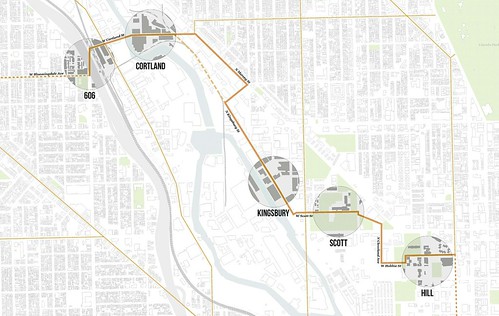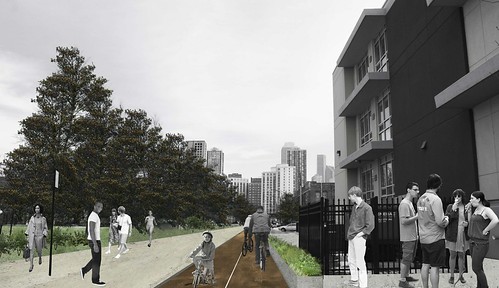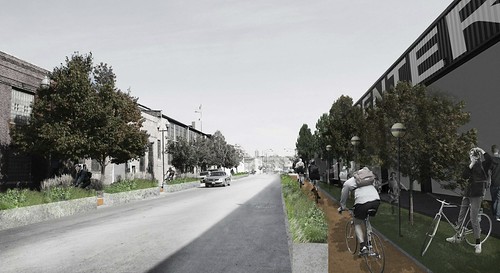
Last month when Chicago Department of Transportation staffers discussed plans for buffered bike lanes on Elston between North and Webster at a meeting hosted by the North Branch Works industrial council, there was stiff resistance from local business owners. Although there's currently a protected lane on the street from Division to North, and a fading conventional lane on this stretch, they argued that encouraging more cycling on the street would interfere with truck movement and endanger bike riders.
As an alternative to upgrading the Elston lanes, the industrial council is now pushing a bike route proposal designed by the architecture firm MAS Studio and bankrolled by Topology, a real estate development company. Dubbed “A New Bike Route,” it features an itinerary connecting the east end of the upcoming Bloomingdale Trail, AKA The 606, to buffered lanes on Wells south of Division, mostly via side streets. The roundabout route includes Cortland, Marcy (although the street shown on the map above is actually Clybourn), Kingsbury (Topology's office is located at 1422 North Kingsbury), Scott, Cleveland, Hobbie and Hill.
“The idea is to make a bike route that is a good ride as an alternative to simply designating a bike lane for a city street,” said Tom Melk, project leader for Topology . “The route weaves its way past retail areas, the Clybourn Metra stop, schools, and employment centers, and through parks, avoiding anonymous areas like the Elston industrial zone.”
“The focus is to create a good ride, an interesting ride, and an efficient way to connect Milwaukee Avenue and the new 606 to Michigan Avenue, River North and the Loop while avoiding difficult, unfriendly intersections… or routes through long tedious and uninteresting neighborhood areas,” he added. “Who wants to bike down Elston anyway?”
Actually, lots of people do. CDOT counts conducted in late summer of 2012 observed an average of 219 cyclists on Elston at Division per two-hour peak period. It’s also clear that upgrading the Elston bike lanes would make even more people choose it as a bike route. Bike counts on the street showed a 55 percent increase in cycling after the protected lanes were installed.
While the stretch between North to Webster is wide enough for protected lanes, the business owners are dead-set against the buffered lane proposal, let alone extending the PBLs north, because they fear more cyclists on Elston would interfere with their shipping operations. Their main reason for promoting the ANBR proposal is to get bikes out of the way of their trucks.
Joe Robinson, a member of Bike Walk Logan Square who teaches at a school on Elston and attended last month’s contentious meeting, doesn't like the idea of using ANBR to keep cyclists off Elston. “It would send bikers on a convoluted route toward Kingsbury, then east into Lincoln Park, basically avoiding our stretch of Elston altogether,” he said. “It's a pretty lousy alternative by my assessment, but maybe I'm wrong.”
Actually, in a vacuum, the proposed route does have redeeming qualities. While it’s indirect, it looks to be a fairly pleasant, bike-friendly route. The presentation shows planter-protected, mostly bi-directional bike lanes along almost the entire route, with missing links in the existing street network, such as at Seward Park, connected by off-street paths. If it could actually be built as illustrated, the route would be a true eight-to-eighty facility, suitable for kids and seniors. Of course it’s likely some neighboring businesses, such as the Finkl steel mill on Cortland, would grumble as loudly as their Elston counterparts about having their streets reconfigured.
While ANBR has it merits and should be considered for future construction, it’s not a replacement for improving safety on Elston, where people are already riding. The street is a faster, more direct way to get downtown – riding from Cortland/Ashland to Daley Plaza via Elston and Milwaukee is a half mile shorter than taking the alternative route. Elston is a necessary bikeway for accessing popular destinations like Stanley’s produce market, North and Elston, and the Hideout music venue, a block east of Elston on Wabansia. And while Elston could potentially be restriped with buffers this spring, the additional planning and cost required for the innovative ANBR bikeways means it probably couldn’t be built until at least 2015.
View Elston Avenue in a larger map
ANBR, shown in orange, is 4 miles; Elston route, in blue, is 3.5.
CDOT has agreed to take ANBR into consideration, and the route will likely be discussed at another meeting with the Elston business owners in February. MAS and Topology's proposal seems well-meaning, and an almost fully protected bike route connecting the Bloomingdale with Wells would certainly be a great asset for Chicago. However, the city still needs to improve safety on Elston, the more direct route.







